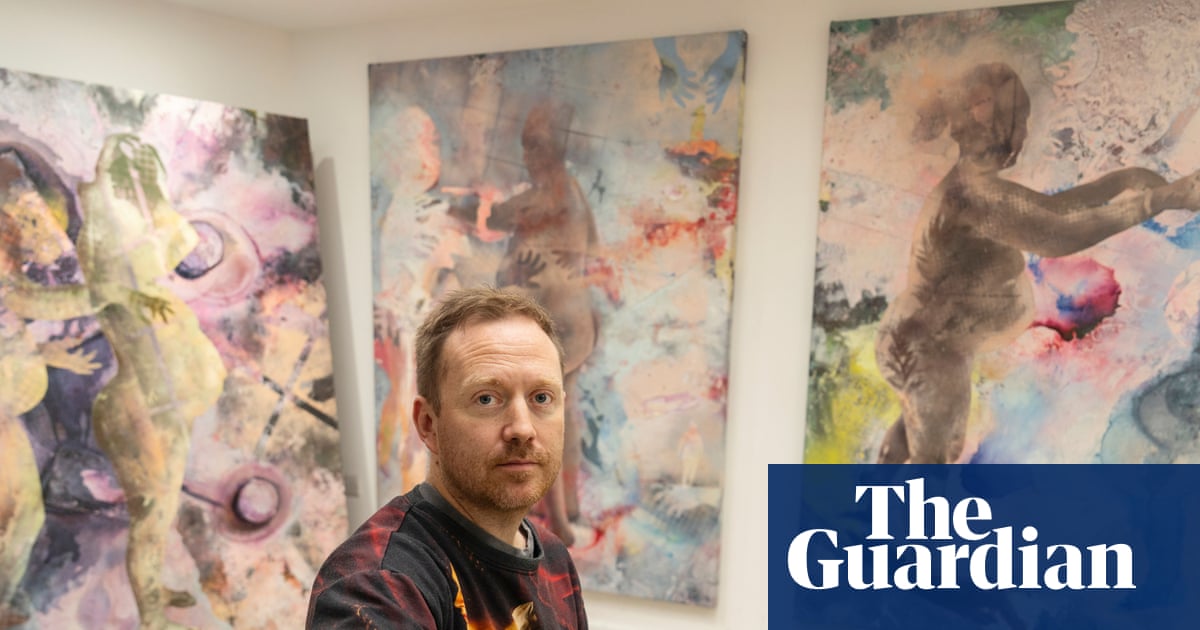‘The subject comes with huge baggage and I like that,” says Tom de Freston. The painter and I are in his studio in a village outside Oxford, surrounded by nude portraits of his wife, the novelist Kiran Millwood Hargrave. “I wanted to ask, ‘What does it mean as a male artist to be looking at the female figure? And where does the agency sit?’”
We have been talking about Titian’s Poesie series, how those paintings – commissioned by the most powerful man in the world at the time, King Philip II of Spain – fetishise the naked female body. “Obviously there’s other things going on in them … I think Titian’s often prodding at morality and power,” De Freston says.
Titian’s works are a central inspiration for works on display as part of Poíēsis, De Freston’s first major exhibition at London’s Varvara Roza Galleries. He has lifted some of Titian’s figures on to his own canvases, playing with the idea of the male gaze.
On the Edge of the Forest. Photograph: Tom de Freston/Peter Mallet Photography
These large-scale paintings are alongside those of Millwood Hargrave at various stages of pregnancy, created as the couple endured seven pregnancy losses before the birth of their daughter, Coral, in 2023. De Freston wrote about the miscarriages – and Titian – in his acclaimed book Strange Bodies, but these paintings were initially not intended to be exhibited, but were rather just a way of processing his own grief. “It was like the studio was my space to work through stuff that was beyond language, without burdening Kiran with it.”
It was also an act of empathy. Over the years, De Freston has painted Millwood Hargrave in a range of mythological guises, but it is the story of Eurydice and Orpheus that resonated the most: her unreachability, his need to look to her, questions about the distances between men and women and of course the feeling of being on the threshold of an underworld of grief and loss, hoping for a pregnancy resulting in a live birth.
You can’t deny the male gaze in these works: it’s there. “You’re trying to get to this figure, or to their unseen internal world. And even though you’re intimately connected to them, you can’t,” he explains. The subject’s unreachability, in other words, is the whole point.
Despite efforts to reframe it, the dynamic between a male artist and his female muse still holds powerful sway in many people’s minds, but De Freston and Millwood Hargrave’s relationship is not one of “active artist and passive subject”. Rather, she is a collaborator. “Her voice is hugely present in the work,” says De Freston.
“These aren’t posed,” agrees Millwood Hargrave, when we speak by phone a few days later. “They are all from photographs that he took in the domestic space throughout my pregnancies.” I ask her if such intimacy being made public feels exposing in any way. “When he first talked to me about using these photographs, I was just excited, because this body of work is the most beautiful I’ve ever seen Tom create,” she says. “They’re not sexualised. They’re worshipful and considered and you can feel the love in them.”
Both of Us Sorting Shadows, 2024. Photograph: Tom de Freston/Peter Mallet Photography
Explorations of pregnancy and especially of miscarriage still feel quite rare in visual art. De Freston has made a bold attempt at empathy and succeeded in capturing that mix of grief and hope. Furthermore, they record a time that is precious. “They do feel like elegies,” says Millwood Hargrave. “I think any painting feels like an act of mourning anyway, because you’re trying to capture something that is gone. We were so ecstatic and scared in this [last] pregnancy.”
skip past newsletter promotion
Your weekly art world round-up, sketching out all the biggest stories, scandals and exhibitions
Privacy Notice: Newsletters may contain information about charities, online ads, and content funded by outside parties. If you do not have an account, we will create a guest account for you on theguardian.com to send you this newsletter. You can complete full registration at any time. For more information about how we use your data see our Privacy Policy. We use Google reCaptcha to protect our website and the Google Privacy Policy and Terms of Service apply.
after newsletter promotion
When baby Coral arrived, De Freston says, “she took a breath, and it instantaneously felt like the whole world somehow unlocked.” He had been scared to become a father because of the impact it might have on his work. Instead, he was flooded with a sense of wonder and connection. “There was a sudden shattering of the lie of the individual,” he says. “You have this sense of you as this artist, with the importance of your vision of the world. And obviously, having a child, you become so intimately aware of the interconnectedness of everything.”
The work he made before parenthood was, by his own admission, very heavy. These paintings are far more hopeful. A lot of magical thinking goes on in pregnancy, especially when you’ve had losses. De Freston agrees: “I think of them as ritualistic, like spells. And in a kind of secular way, like prayers.”

